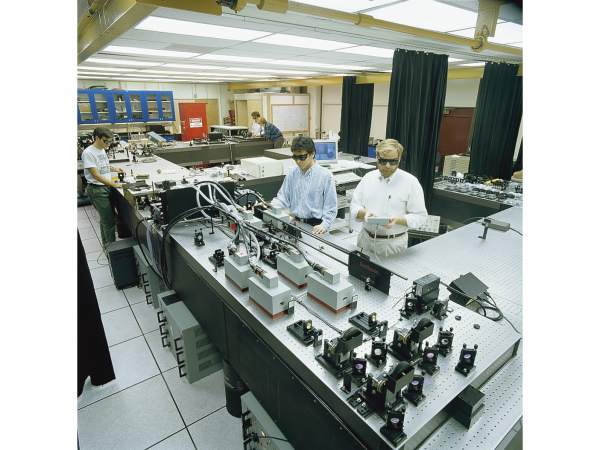
The configuration of large, laser-based experimental and production systems can change dramatically as equipment is added, modified, and removed. Because traditional vibration isolation tables cannot physically accommodate the necessary changes, a new table is often needed with each major design iteration. As a result, table costs are a major factor driving system modification. A modular table system, however, provides a more practical and cost-effective alternative for large systems that need more reconfiguration flexibility than traditional table systems can provide.
The modular table system was originally conceived by Christopher P. J. Barty, director of high-intensity laser science at the University of California at San Diego. The first modular system, installed in November 1994, is the foundation for an ultrafast laser that is designed to produce sub-20-fs pulses with peak intensities in the tens of terawatts. Several research teams will use the laser simultaneously for their projects, so the modular design allows each team to “build out” a section of the table to fit its special requirements. As each team completes its project, the next team to occupy the same area can reconfigure the table to suit its particular needs.
The modular table consists of 4 ft x 4 ft table modules that can be readily attached to adjacent modules on any side. By connecting modules together, a virtually unlimited number of two-dimensional table shapes can be quickly and easily constructed. Changing the shape of the table is simply a matter of removing or adding modules in the desired locations. In addition to the 4 ft x 4 ft modules, 2 ft x 4 ft modules allow greater control of table arm length. The modular concept makes it possible for facilities with many systems to stock standard modules, permitting fast and inexpensive modification of existing systems and “zero lead-time” construction of new systems. Furthermore, instead of purchasing dedicated table systems for every new project, table investment is reduced because modules and isolators may be returned for reuse upon project completion. In the long run, this can result in a dramatic reduction in vibration-isolation-system costs.
Figure 1. This modular ultrafast system will produce two independent short-pulse beams, a high intensity 10 Hz beam generating >1J before compression, and a comparatively low intensity 50 Hz beam with pulses in excess of 100 mJ before compression. Both systems produce amplified pulses on the order of 20 fs.
Because of the large size and weight of the total table systems, each module is specially designed to withstand high static loads. Internal modules construction uses a high-shear-modulus honeycomb core fabricated from bonded steel. High static stiffness between modules is maintained by 3/4-in.-thick steel plates on all four sides. The standard work surface is ferromagnetic stainless steel with corrosion-proof sealed mounting holes with options for other work surfaces and mounting-hole patterns.
For systems that require the highest level of stability, table modules can be equipped with tuned vibration dampers for improved dynamic performance. Every structure has characteristic vibration modes at specific frequencies; optimal damping of these resonances dissipates vibrational energy. Most tables use so-called “broadband” damping techniques that provide indiscriminate damping over of wide range of frequencies. Hermetically sealed tuned dampers enhance stability by concentrating damping where it is needed most—at the table’s resonant frequencies. As a result, tuned dampers provide damping that is approximately one order of magnitude more efficient than conventional damping techniques under all load conditions.
The tabletop modules are supported by a number of pneumatic vibration isolators that prevent both vertical and horizontal floor vibrations from affecting equipment mounted on the table top.

Figure 2. Modular table system, shown during construction of the high-energy laser system at the University of California (San Diego, CA), consists of seventeen 4 x 4-ft modules, three 2 x 4-ft modules, and 28 pneumatic isolators.
For high rigidity, modules are connected by means of machined, box-section steel interface adaptors attached along the top and bottom edges of adjoining modules. The module assembly procedure is straightforward and can be performed by two people.
One important advantage that table modules offer over single-panel tables is easier transportation to the assembly site. The large size of traditional table panels often dictates the use of heavy equipment and special facility modifications such as doorway widening or wall knockouts. In contrast, modules easily fit through a standard doorway and can be transported in most building elevators.
Through-holes in each interface adaptor can be used for routing cables, cooling lines, and laser beams by simply machining a hole in the top plate. Tapped holes in the interface adaptors also facilitate attachment of shelves below the table for lasers and other equipment. Side panels feature an array of tapped holes for convenient mounting of equipment to the sides of the modules.
Newport offers various vibration isolation tables and systems for your application needs. With more than 40 years of experience in designing and manufacturing vibration control (isolation, damping) systems, Newport provides you with the industry leading performance system, and user friendly products and solutions. That includes our standard Vibration Control product offerings (optical tables, vibration isolators, optical workstation, etc.), or our Vibration Control Custom Solutions (custom optical tables, custom vibration isolators, cradle system, etc.). In this application note, we will introduce to you our modular vibration isolation table solutions, and you will learn how that will help with your laboratory configurations.